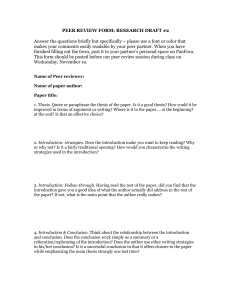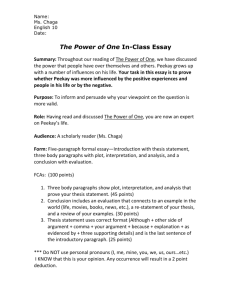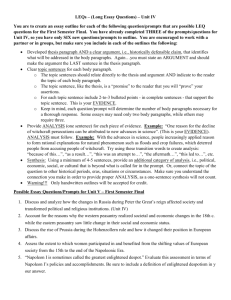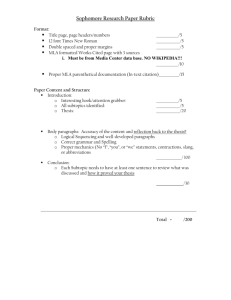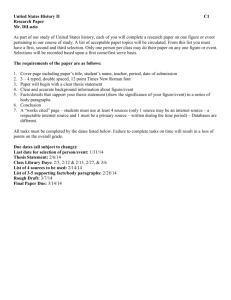Guide to Writing for College
advertisement
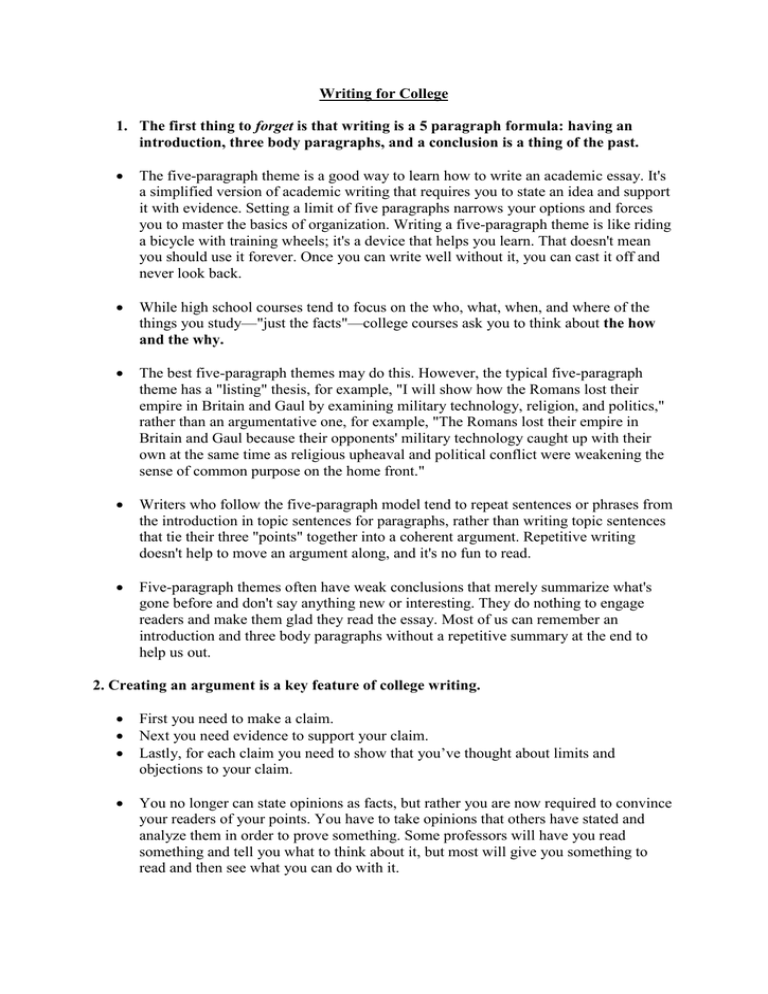
Writing for College 1. The first thing to forget is that writing is a 5 paragraph formula: having an introduction, three body paragraphs, and a conclusion is a thing of the past. The five-paragraph theme is a good way to learn how to write an academic essay. It's a simplified version of academic writing that requires you to state an idea and support it with evidence. Setting a limit of five paragraphs narrows your options and forces you to master the basics of organization. Writing a five-paragraph theme is like riding a bicycle with training wheels; it's a device that helps you learn. That doesn't mean you should use it forever. Once you can write well without it, you can cast it off and never look back. While high school courses tend to focus on the who, what, when, and where of the things you study—"just the facts"—college courses ask you to think about the how and the why. The best five-paragraph themes may do this. However, the typical five-paragraph theme has a "listing" thesis, for example, "I will show how the Romans lost their empire in Britain and Gaul by examining military technology, religion, and politics," rather than an argumentative one, for example, "The Romans lost their empire in Britain and Gaul because their opponents' military technology caught up with their own at the same time as religious upheaval and political conflict were weakening the sense of common purpose on the home front." Writers who follow the five-paragraph model tend to repeat sentences or phrases from the introduction in topic sentences for paragraphs, rather than writing topic sentences that tie their three "points" together into a coherent argument. Repetitive writing doesn't help to move an argument along, and it's no fun to read. Five-paragraph themes often have weak conclusions that merely summarize what's gone before and don't say anything new or interesting. They do nothing to engage readers and make them glad they read the essay. Most of us can remember an introduction and three body paragraphs without a repetitive summary at the end to help us out. 2. Creating an argument is a key feature of college writing. First you need to make a claim. Next you need evidence to support your claim. Lastly, for each claim you need to show that you’ve thought about limits and objections to your claim. You no longer can state opinions as facts, but rather you are now required to convince your readers of your points. You have to take opinions that others have stated and analyze them in order to prove something. Some professors will have you read something and tell you what to think about it, but most will give you something to read and then see what you can do with it. In bigh school summary means to restate. In college however summary is merely yes or no- but to instead make a claim about the summary you read. Everything you write should have a point or thesis statement. Everything that you show/prove/claim/argue/demonstrate must link to the central thesis. A good thesis says something significant. It does not say something that the reader already knows, and it is at least mildly contestable. o Socrates’ argument is very interesting. This point is not significant. The reader already knows that Socrates is interesting; no one would contest this point. 3. Now let’s look at an example: Prompt: Compare and contrast the reasons why the North and South fought the Civil War. In a high school paper, one would think: "What are three points I can talk about to compare the reasons the North and South fought the Civil War?" You do a little brainstorming, and say, economy, politics, and slavery. I guess I can do a paper about that. So here is the introduction you write: A civil war occurs when two sides in a single country become so angry at each other that they turn to violence. The Civil War between North and South was a major conflict that nearly tore apart the young United States. The North and South fought the Civil War for many reasons. In some cases, these reasons were the same, but in other cases they were very different. In this paper, I will compare and contrast these reasons by examining the economy, politics, and slavery. This is a classic five-paragraph theme introduction: it goes from the general to the specific, and it introduces the three points that will be the subjects of each of the three body paragraphs. But Professor College doesn't like it, not one little bit. She underlines the first two sentences, and she writes, "This is too general. Get to the point." She underlines the third and fourth sentences, and she writes, "You're just restating the question I asked. What's your point?" She underlines the final sentence, and then writes in the margin, "What's your thesis?" because the last sentence in the paragraph only lists topics. It doesn't make an argument. For a college paper, you should instead: Comes up with a main argument, or thesis, that answers the question "Why did the North and South fight the Civil War?" Then decide how to organize your draft by thinking about the argument's parts and how they fit together. Thesis: Both Northerners and Southerners believed they fought against tyranny and oppression, but Northerners focused on the oppression of slaves while Southerners defended their rights to property and self-government. Organization: First you’ll write a paragraph that gives background; you'll explain how opposition to tyranny and a belief in individual liberty came to be such important values in the United States. Then write another background paragraph in which you show how the conflict over slavery developed over time. Then you'll have separate paragraphs about Northerners and Southerners, explaining in detail—and giving evidence for—claims about each group's reasons for going to war. Note there are now four body paragraphs. You might have had three or two or seven; what's important is that you allow your argument to tell how many paragraphs you should have and how to fit them together. Then you conclude perhaps by pointing out that the fissures in our society that the Civil War opened are, in many cases, still causing trouble today. Now it’s your turn: Which are ready for college? 1. Cemeteries are just buried stories. 2. Child labor became a severe problem during the industrial revolution. 3. Every story has ghosts- the unknown secrets of the story teller that reside between the lines on a page. 4. The choices made today affect tomorrow’s outcomes. 5. The women in Othello, specifically Desdemona and Emilia, while converse characters, function as the demise of the men in their lives. 6. Any death is distressing for those who mourn for one passed; however, the death of a child is especially calamitous. 7. Shakespeare revealed that the English language is never dormant but constantly developing. Prompt: Discuss how the Wizard of Oz relates to modern day society. Your thesis: ___________________________________________________________________________ ___________________________________________________________________________ ___________________________________________________________________________ ___________________________________________________________________________ ___________________________________________________________________________

